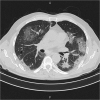Navigating the Diagnostics of COVID-19
- PMID: 32838176
- PMCID: PMC7381857
- DOI: 10.1007/s42399-020-00408-8
Navigating the Diagnostics of COVID-19
Abstract
The recent outbreak of the severe acute respiratory syndrome coronavirus 2 (SARS-CoV-2) began in Hubei province, China, in December 2019 and has spread worldwide at an alarming rate. With over eight million individuals infected and exceeding 400,000 deaths globally, the necessity to develop fast and efficient diagnostic methods is of high importance. This paper reports on currently available diagnostic screening methods for patients infected with SARS-CoV-2 to guide frontline healthcare workers involved with the diagnosis of 2019 novel coronavirus disease (COVID-19) patient. An electronic literature search was performed for peer-reviewed articles published from January 1, 2020, until June 19, 2020. Published articles were then reviewed and included based on the applicability to the topic. The preferred diagnostic approach is the reverse transcription (RT) of the virus' ribonucleic acid (RNA) followed by polymerase chain reaction (PCR) amplification (RT-PCR). However, this method has been proven to be time-consuming. In improving the speed and efficiency of diagnostics, newer rapid diagnostic serological tests are in development for testing SARS-CoV-2, each with its unique advantages and disadvantages. They could potentially be used as triage tests to rapidly identify patients who are very likely to have COVID-19 in combination with other accurate diagnostic methods, such as diagnostic imaging. A combination of the disease history, clinical manifestations, laboratory diagnostic testing, and diagnostic imaging is crucial for making an accurate and useful diagnosis for COVID-19. Hopefully, the continuous development and use of rapid diagnostic tests and the implementation of public health measures will help control the spread of the disease.
Keywords: COVID-19; Diagnostic test; RT-PCR; SARS-CoV-2; Serology.
© Springer Nature Switzerland AG 2020.
Conflict of interest statement
Conflict of InterestThe authors declare that they have no conflict of interest.
Figures


Similar articles
-
Development and Clinical Application of a Rapid and Sensitive Loop-Mediated Isothermal Amplification Test for SARS-CoV-2 Infection.mSphere. 2020 Aug 26;5(4):e00808-20. doi: 10.1128/mSphere.00808-20. mSphere. 2020. PMID: 32848011 Free PMC article.
-
Laboratory-Based Resources for COVID-19 Diagnostics: Traditional Tools and Novel Technologies. A Perspective of Personalized Medicine.J Pers Med. 2021 Jan 13;11(1):42. doi: 10.3390/jpm11010042. J Pers Med. 2021. PMID: 33451039 Free PMC article. Review.
-
Effectiveness and cost-effectiveness of four different strategies for SARS-CoV-2 surveillance in the general population (CoV-Surv Study): a structured summary of a study protocol for a cluster-randomised, two-factorial controlled trial.Trials. 2021 Jan 8;22(1):39. doi: 10.1186/s13063-020-04982-z. Trials. 2021. PMID: 33419461 Free PMC article.
-
Characteristics of Ocular Findings of Patients With Coronavirus Disease 2019 (COVID-19) in Hubei Province, China.JAMA Ophthalmol. 2020 May 1;138(5):575-578. doi: 10.1001/jamaophthalmol.2020.1291. JAMA Ophthalmol. 2020. PMID: 32232433 Free PMC article.
-
Molecular and Serological Tests for COVID-19 a Comparative Review of SARS-CoV-2 Coronavirus Laboratory and Point-of-Care Diagnostics.Diagnostics (Basel). 2020 Jun 26;10(6):434. doi: 10.3390/diagnostics10060434. Diagnostics (Basel). 2020. PMID: 32604919 Free PMC article. Review.
Cited by
-
Association of Pre-Existing Comorbidities with Disease Severity Among COVID-19 Patients in Eastern Ethiopia.Infect Drug Resist. 2022 Jun 1;15:2825-2834. doi: 10.2147/IDR.S362140. eCollection 2022. Infect Drug Resist. 2022. PMID: 35673546 Free PMC article.
-
Current and innovative methods for the diagnosis of COVID‑19 infection (Review).Int J Mol Med. 2021 Jun;47(6):100. doi: 10.3892/ijmm.2021.4933. Epub 2021 Apr 13. Int J Mol Med. 2021. PMID: 33846767 Free PMC article. Review.
-
SARS-CoV-2 infection and liver involvement.Hepatol Int. 2022 Aug;16(4):755-774. doi: 10.1007/s12072-022-10364-1. Epub 2022 Jun 29. Hepatol Int. 2022. PMID: 35767172 Free PMC article. Review.
-
Clinical and radiological characteristics of COVID‑19 patients without comorbidities : A single-center study.Wien Klin Wochenschr. 2021 Sep;133(17-18):875-881. doi: 10.1007/s00508-021-01880-5. Epub 2021 Jun 3. Wien Klin Wochenschr. 2021. PMID: 34081191 Free PMC article.
-
Recent Advances in Plasma-Engineered Polymers for Biomarker-Based Viral Detection and Highly Multiplexed Analysis.Biosensors (Basel). 2022 Apr 28;12(5):286. doi: 10.3390/bios12050286. Biosensors (Basel). 2022. PMID: 35624587 Free PMC article. Review.
References
-
- Adhikari SP, Meng S, Wu Y-J, Mao Y-P, Ye R-X, et al. Epidemiology, causes, clinical manifestation and diagnosis, prevention and control of coronavirus disease (COVID-19) during the early outbreak period: a scoping review. Infect Dis Poverty. 2020;9(29) Accessed April 20, 2020. 10.1186/s40249-020-00646-x. - PMC - PubMed
-
- van Doremalen N, Bushmaker T, Morris DH, Holbrook MG, Gamble A, Williamson BN, Tamin A, Harcourt JL, Thornburg NJ, Gerber SI, Lloyd-Smith JO, de Wit E, Munster VJ. Aerosol and surface stability of SARS-CoV-2 as compared with SARS-CoV-1. N Engl J Med. 2020;382:1564–1567. doi: 10.1056/NEJMc2004973. - DOI - PMC - PubMed
Publication types
LinkOut - more resources
Full Text Sources
Miscellaneous
